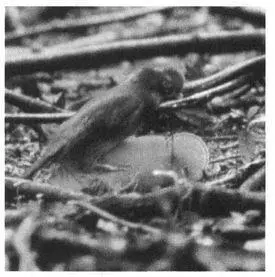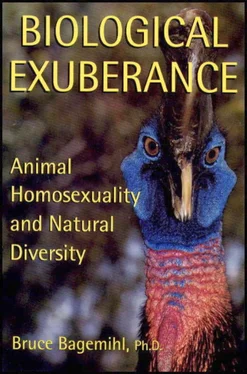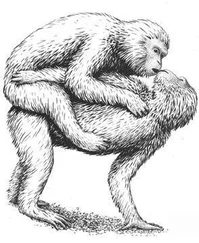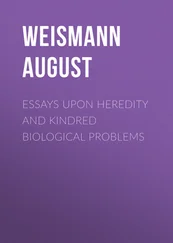*Nisbet, 1. C. T., J. A. Spendelow, J. S. Hatfield, J. M. Zingo, and G. A. Gough (1998) “Variations in Growth of Roseate Tern Chicks: II. Early Growth as an Index of Parental Quality,” Condor 100:305–15.
Penland, S. T. (1984) “An Alternative Origin of Supernormal Clutches in Caspian Terns.” Condor 86:496.
*Sabo, T. J., R. Kessell, J. L. Halverson, I. C. T. Nisbet, and J. J. Hatch (1994) “PCR-Based Method for Sexing Roseate Terns ( Sterna dougallii). ” Auk 111:1023–27.
Shealer, D. A., and J. G. Zurovchak (1995) “Three Extremely Large Clutches of Roseate Tern Eggs in the Caribbean.” Colonial Waterbirds 18:105–7.
*Spendelow, J. A., and J. M. Zingo (1997) “Female Roseate Tern Fledges a Chick Following the Death of Her Mate During the Incubation Period.” Colonial Waterbirds 20:552–55.
Perching Birds and Songbirds
COTINGAS, MANAKINS, AND OTHERS

IDENTIFICATION: A small (10 inch) perching bird; adult males are brilliant orange with elaborate fringed wing plumes and an imposing helmetlike feather crest; adolescent males have mottled brown and orange plumage, while females are uniformly dark. DISTRIBUTION: Northern South America, primarily in southern Venezuela, the Guianas, adjacent parts of Brazil. HABITAT: Forests, usually near cliffs, mountains, or rock outcrops (on which females build their nests, giving the bird its name). STUDY AREA: Raleigh falls–Voltzberg Nature Reserve, Suriname, South America.
Social Organization
The spectacularly plumed Guianan Cock-of-the-Rock has what is known as a LEK social and mating system: males inhabit individual territories, usually clustered in the same area, which are used for display and courtship. Each display “court” consists of a cleared area on the forest floor and surrounding perches. Territories are maintained year-round, but courtship and mating occur only from late December through April. Females (and in this species, young males) visit these territories to choose which males they want to mate with. Other than this, males and females lead virtually separate lives: males do not participate in any aspect of nesting or parental care and rarely encounter females outside of the breeding season.
Description
Behavioral Expression: Homosexual activity between adult and adolescent males, as well as among adolescent males, is a routine occurrence in Guianan Cock-of-the-Rock. Males court and display to each other, as well as engage in homosexual mounting. A typical homosexual encounter begins when the adult males are perched beside their display courts, each glowing like an orange beacon in the jungle gloom. Both females and adolescent (yearling) males are attracted to the lek, which is carefully situated in the forest to take advantage of the ambient light characteristics of the environment (thereby showing off its owner to his best advantage). The courtship sequence commences with a GREETING DISPLAY: the males begin calling raucously, then each drops to the ground with a thump and begins beating his wings violently, flashing patches of black and white. This often produces a whistling sound as air rushes through the specially modified wing feathers.
This attention-grabbing sequence is followed by the GROUND DISPLAY: each adult male crouches down, fanning out the delicate filaments of his wing coverts, puffing out his chest and rump feathers and erecting his crest, resulting in a spectacular visual effect. By this time an adolescent male who is attracted by the display has landed beside the adult and is hopping about the display court, often crouching in a version of the courtship posture himself. The adult keeps his back toward the younger male at all times but is otherwise motionless, showing off his plumage to its best and inviting the adolescent to mount him. During homosexual copulation, the younger male climbs onto the adult’s back and perches firmly, moving his tail sideways to try to make genital contact. Often the younger male mounts the older male several times in succession, and courtship and display often alternate with mountings. Sometimes males also mount each other in the trees surrounding a display court. Homosexual interactions differ from heterosexual ones in that both participants perform some version of the ground display; also, unlike females, neither male pecks at or touches the other’s rump prior to mounting.
Adolescent males usually visit the display courts of several adult males, although some adults are clearly more “popular” than others because they receive more attention from the younger males. Typically, a yearling has homosexual interactions with anywhere from one to seven different adult males during the mating season. Nor does homosexual activity always involve an adult territory owner and a yearling male: adolescents often mount nonbreeding males who do not have their own display territories and sometimes also mount other adolescent males. Homosexual activity is not separate from heterosexual courtship and copulation, but takes place in the same locations and often while male-female interactions are happening in the vicinity. However, homosexual courtship and mounting often take priority over heterosexual interactions. If an adolescent male approaches an adult who is courting a female, the female usually leaves (or is chased away), and the two males turn their attentions to each other. Moreover, if a female encounters a male who is courting or involved sexually with another male, she usually waits until the adolescent male leaves before approaching the adult.
A younger (adolescent) male Guianan Cock-of-the-Rock mounting a bright orange adult male in the forests of Suriname

Frequency: Homosexual activity is very common among Guianan Cock-of-the-Rock: in fact, mountings between males are as frequent as male-female mountings, accounting for nearly half of all copulations. About 10 percent of heterosexual courtships are interrupted by adolescent males visiting the courting male; roughly one out of five of these “interruptions” involves courtship or sexual behavior between males. During the breeding season, homosexual activity may occur daily, and an adolescent male will usually have 6–7 homosexual encounters over the season (although some males engage in homosexual mounting more frequently, 15 or more times over a season).
Orientation: Close to 40 percent of the male population participates in some form of homosexual activity. Depending on his age, a bird that has same-sex interactions may or may not also engage in heterosexual activity. Among adult males (three years or older), nearly a quarter (23 percent) are mounted by other males, and 6 percent of these do not mate or court females at all. In fact, those adults who do not mate heterosexually are often the ones most frequently mounted by younger males. Among yearling males (virtually none of whom mount females), almost two-thirds (64 percent) engage in homosexual activity. Two-year-old males, on the other hand, very rarely engage in homosexual activity. Thus, when birds of all ages are taken into account, nearly 20 percent of the male population at any given time is involved exclusively in homosexuality.
Nonreproductive and Alternative Heterosexualities
As described above, male and female Guianan Cock-of-the-Rock have essentially no contact with each other outside of the mating season. Even during the breeding season, their interactions are often unfriendly or overtly aggressive. Males frequently harass females by chasing them around the display court and in some cases attempt to forcibly copulate with them. Females struggle violently during these rape attempts and are usually able to get away, but are visibly stressed following such interactions. In fact, only 20 percent of all lek visits by females result in copulation. There is also a significant proportion of nonbreeding individuals in the population: an average of 20 percent of adult males do not have display territories (and thus rarely, if ever, court or mate with females), while nearly two-thirds of territorial males fail to mate each year. Moreover, males are rarely able to acquire their own territories (and therefore court females) before they are three to four years old. In addition, many females who visit the courtship grounds never actually mate with males during the entire breeding season.
Читать дальше














